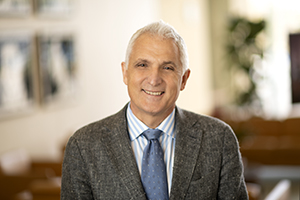How Ionis Pharmaceuticals Is Advancing Multiple Late-Stage Trials During COVID

By Ed Miseta, Chief Editor, Clinical Leader

Ionis Pharmaceuticals has experienced substantial growth since its founding in 1990. The company used to boast that it had one drug for every 10 employees, from the cleaning staff up to the CEO. With the acquisition of Akcea Therapeutics in the fall of 2020, Ionis now has a pipeline of 47 products based on its antisense technology platform, which allows for the rapid discovery of new drugs. The company’s work in RNA-targeted drug development allows it to treat diseases in millions of patients where no other approaches have proven effective.
Dr. Sam Tsimikas is the SVP of global cardiovascular development at Ionis and has been with the company since 2014. He notes the company’s antisense technology is a form of RNA therapeutics which is different than small interfering RNA, which some of its competitors are pursuing. Currently there are less than 10 drugs approved in the RNA therapeutic sphere.
“The early chemistry of RNA treatments hindered its development,” says Tsimikas. “When the field first got underway, the chemistry required large doses and frequent treatment of patients. Since then, the science has transformed and has gone through several iterations. We are now at an inflection point. It has been a long road to get where we are, which is proving that RNA therapeutics work. There are now over 50 companies in the U.S. and another 20 or 30 outside the U.S. working on RNA therapeutics.”
Partnering For Success
The model used by Ionis, until recently, revolved around partnering with other companies. In some therapeutic areas, Big Pharma companies cannot compete with Ionis because they do not have access to the company’s proprietary technology. But they can license the technology. Ionis currently has partnering agreements in place with Pfizer, AstraZeneca, Roche, Bayer, Biogen, and Novartis.
Ionis also works with CRO partners to help advance its pipeline. The company likes to say that it keeps the brains inhouse but will outsource the brawn.

A competitive bidding process is used to select the CRO partner for each study. Tsimikas notes the same CRO is not used for each study, and the company values accurate feasibility studies and a CRO’s knowledge of sites and their ability to recruit patients. Many of the CROs selected will have expertise in specific therapeutic areas. Although a CRO search process is conducted for each new trial, he notes the company has a good relationship with Medpace and has used that partner in multiple studies.
“Patient recruitment is one of the critical areas where your CRO can really assist with the study,” says Tsimikas. “An investigator might tell you they can recruit 20 patients and then only produce one. The good CROs have worked with most sites and can give you a more accurate and reliable determination of the number of patients a site can potentially deliver. They know what numbers are real and which are more enthusiasm than reality.”
Ionis has faced some criticism from Wall Street for offloading some drugs too early, before they reached their peak value. There is now a new push within the company to retain assets for a longer period of time, even taking them through to commercialization. Currently, around 20 products in the company pipeline have not been licensed out to any company.
COVID Forces Changes
When the pandemic hit, companies with one or two active trials had to scramble to protect patients while keeping the studies on track. When your company has 47 ongoing trials, the demand is much greater.
“The main goal of a clinical trial is to gather data,” states Tsimikas. “Trials are not always lean, as you want to gather as much data as possible, especially in a Phase 2 study. What COVID really forced us to do was look at the visits we had scheduled and ask if the data that would be collected was really necessary.”
Ionis took a close look at its protocols and made modifications to make trials more patient friendly. If a 75-year-old patient was participating in a trial, the last thing the company wanted to do was force them to visit a clinic to get a blood test.
“If that blood test had to be performed, we made arrangements for a phlebotomist to visit their home,” adds Tsimikas. “We also arranged for nurses to perform home visits to administer injections. We even worked closely with investigators to make sure they gave an accurate reflection of the trial to their patients. That made a big difference.”
A Patient Focus
Ionis was already performing remote data gathering before the pandemic hit hard in 2020. Tsimikas notes that is often necessary in the rare disease space. For example, in Canada a patient may need to see a doctor in a clinic that is 250 miles away. In that situation, you must be aware of how many visits you are asking them to make. If a patient’s travel time to the clinic would amount to more than four hours, medical personnel would be sent to their homes. “In those situations, you have to go to the patient,” says Tsimikas. “You can’t make them come to you.”
Ionis also worked with a company that allowed them to send a kit to a patient’s home. The kit enabled patients to perform their own blood draw without the use of a needle injection. Once done, the kit was shipped back.
“That type of technology is very useful during a pandemic,” says Tsimikas. “It was like an auto phlebotomy. I don’t believe some of these technologies are ready for prime time, but they did allow us to keep patients away from clinics when it was necessary to do so.”
COVID also forced Ionis to be nimble. Many of its trials were global, and not every country was shut down at the same time. That allowed the company to delay trials in areas where the pandemic was taking hold while maintaining data collection in areas that were less impacted. The increased focus on patients also helped the company continue to recruit patients throughout the pandemic.
Tsimikas believes the future looks bright for Ionis and its pipeline. “The beauty of our technology is a lot of our drugs are either first-in-class or best-in-class,” he adds. “Many of these treatments will help patients who have no treatment options. We have the opportunity to bring treatments to patients who really need them.”
